As the groups for European Championship qualification comes to a close, the Netherlands secured their first qualification to a major tournament since the 2014 World Cup in Brazil. To edge themselves over the line, a 0-0 draw against Michael O’Neill’s Northern Ireland at Windsor Park.
The point apiece saw the Oranje remain three points ahead of their opponents in second place, trailing Group C leaders, Germany, by two points with a game left to play. Due to Ronald Koeman’s side’s 3-1 victory in the reverse fixture at Feyenoord’s De Kuip, the Netherlands qualified for the tournament next summer.
This tactical analysis will examine key areas of the two sides’ tactics and use analysis to highlight how those features led to the final score, a 0-0 draw.
Lineups
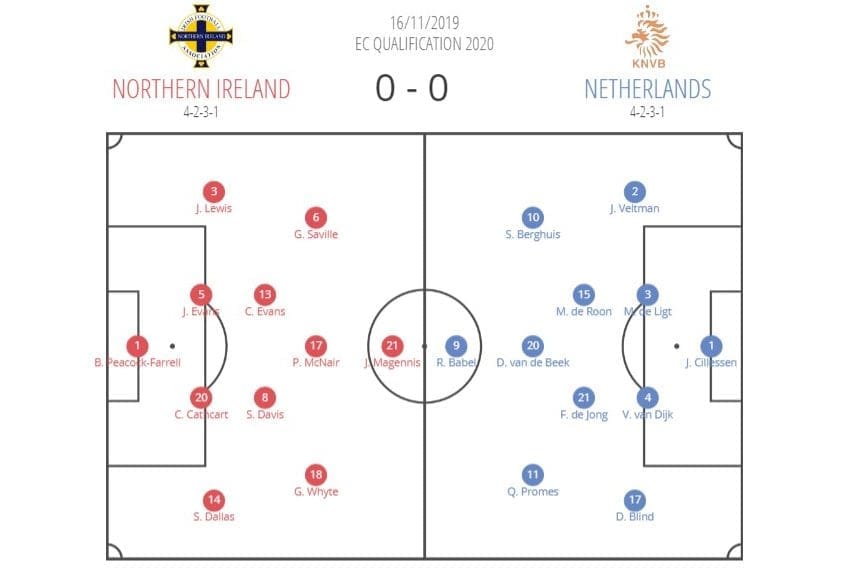
The home side opted for a change in structure and personnel after their 3-2 away victory over the Czech Republic last time out. O’Neill switched from a, rarely used, 3-5-2 to a familiar-looking 4-2-3-1 – which is not all that different to the Green and White Army’s usual formation of choice, 4-3-3. In terms of squad changes, there were five alterations to the starting lineup, presumably to facilitate the change in shape. Michael McGovern, Tom Flanagan, Jordan Thompson, Conor McLaughlin and Liam Boyce made way for Bailey Peacock-Farrell, Jamal Lewis, Cornelius Evans, George Saville and Josh Magennis,
Koeman also opted for several changes to his starting lineup and a change in the Oranje’s structure following their last outing, a 2-1 away victory over Belarus. Although only a small alteration in structure, the Netherlands switched their classic 4-3-3 for a 4-2-3-1. In terms of personnel alterations, three swaps were made in the starting XI. Georginio Wijnaldum, Steven Bergwijn and Donyell Malen were switched for Marten de Roon, Steven Berghuis and Ryan Babel.
The Netherlands’ steady build-up play
In the clash at Windsor Park, the Netherlands enjoyed a whopping 70% of the possession and made 388 more passes than their opponents – 685 in total compared to Northern Ireland’s 297. This was due to the visitors’ steady build-up play from the back and using the ball to do the work, as opposed to the Oranje players. Koeman’s side would work in neat triangles to move the ball around, whilst attempting to tempt the hosts to press high, allowing the visitors to play a long ball into the opposite wide area and cut out Northern Ireland’s attacking and midfield thirds.
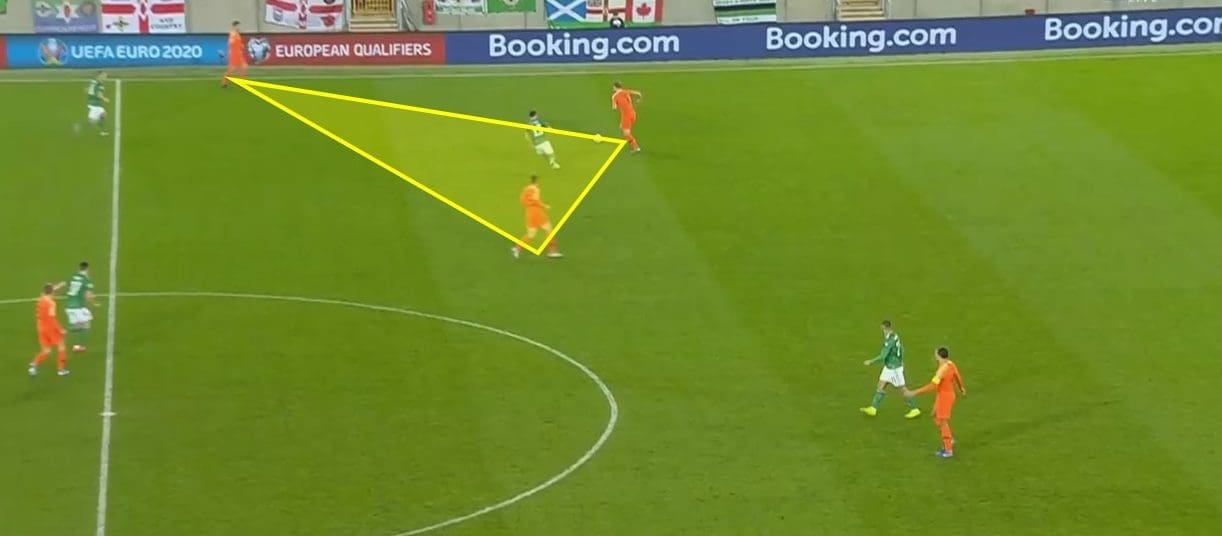
As can be seen above, one of the Netherlands’ passing triangles can be seen in action. The principle is simple yet effective when performed correctly, the movement of the ball between players – who are shifting into open space – makes the presser close the ball down and begin to tire more quickly. Evidence of this makes it no wonder that the Oranje were able to score three late goals against O’Neill’s side in the reverse fixture.
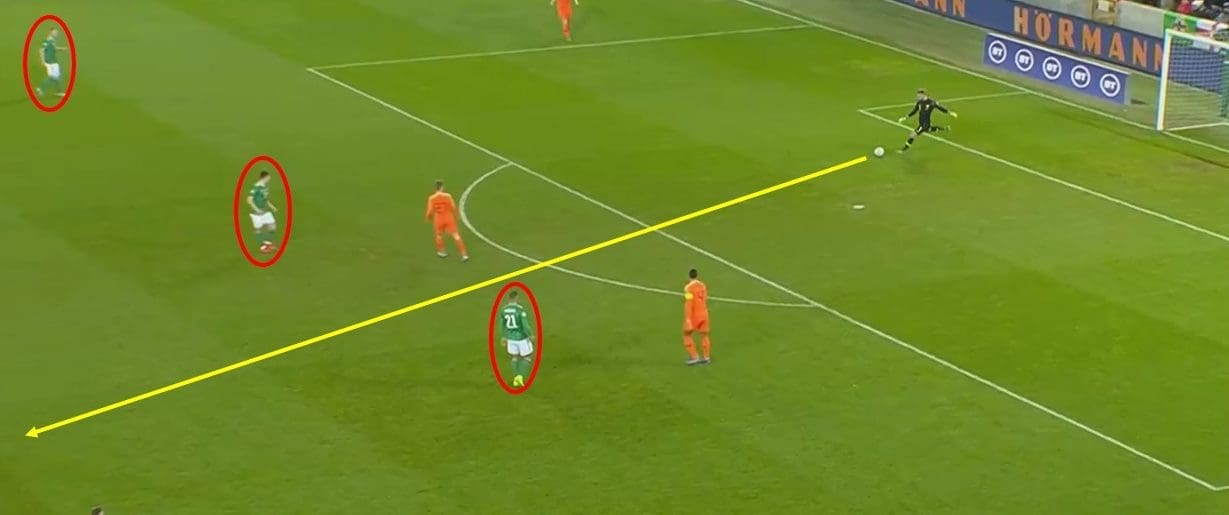
Here, is where the Netherlands’ possession-based build-up play became undone. The goal of their short and sharp passes within triangles was to invite pressure and suck the Northern Irish into a trap. Should the hosts have continued to press high, as Koeman wanted after possession was tidily worked backwards, Jasper Cillessen would cut out the Green and White Army’s attacking and middle third with a long ball wide to Berghuis or Quincy Promes. However, O’Neill’s side held firm and did not take the invite of pressure unless there was a real possibility of winning the ball back.
Northern Ireland’s time to set up defensively
As a result of Northern Ireland not taking the proverbial bait, the Netherlands went hungry in front of goal. Due to their attacking third’s intelligence, the hosts were able to effectively set up in their defensive structure – lining up in a 4-4-1-1 when out of possession. Without receiving the desired pressure from Northern Ireland, the Netherlands’ build-up play seemed slow and with little penetration, as they would retain the ball for large periods, without being presented with the gaps to play the ball through.
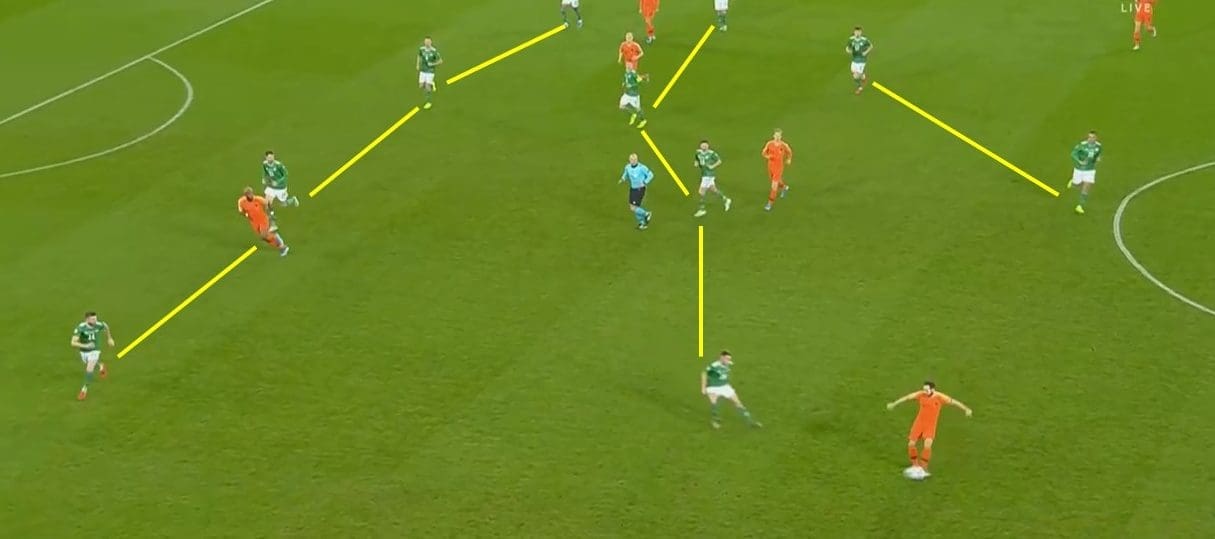
As can be seen in the above annotation, when the Oranje began to advance into the final third of O’Neill’s side, the hosts would sit back into their 4-4-1-1 and make penetrating passes difficult to play for the visitors. This stifled Koeman’s frontline in their quality of chances, as they managed to force 14 shots at Peacock-Farrell’s goal, only three of which were on target.
The Netherlands’ longitudinal zonal marking
The debate of whether to mark zonally or man for man is one that divides many. However, Koeman deployed his usual zonal marking in the stalemate at Windsor Park. From set-pieces, the Oranje would line up laterally, in a line across the pitch, but split the pitch up longitudinally – with each player having a long zone to occupy. This was also seen when defending in open play and led to the awarding of the first-half penalty for the Green and White Army – which will be discussed later in the tactical analysis.
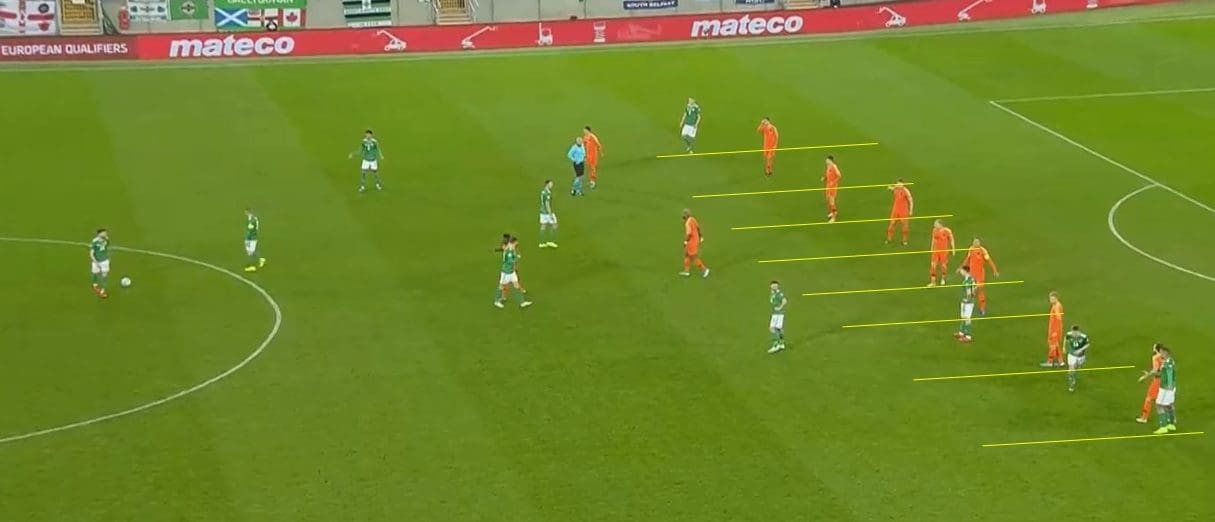
The above annotation shows the Netherlands’ longitudinal zonal marking, with each defensive player occupying a two-to-three-yard wide section of the pitch. The principle of this is simple; in that, if the ball is played into the zone in which the defensive player is marking, it is their job to clear the ball from that area. While the principle is simple, in practice, it is a little more difficult, as the home side used this to their advantage, as can be seen in the difference between marking prior (above) and post (below) Northern Ireland winning the penalty.
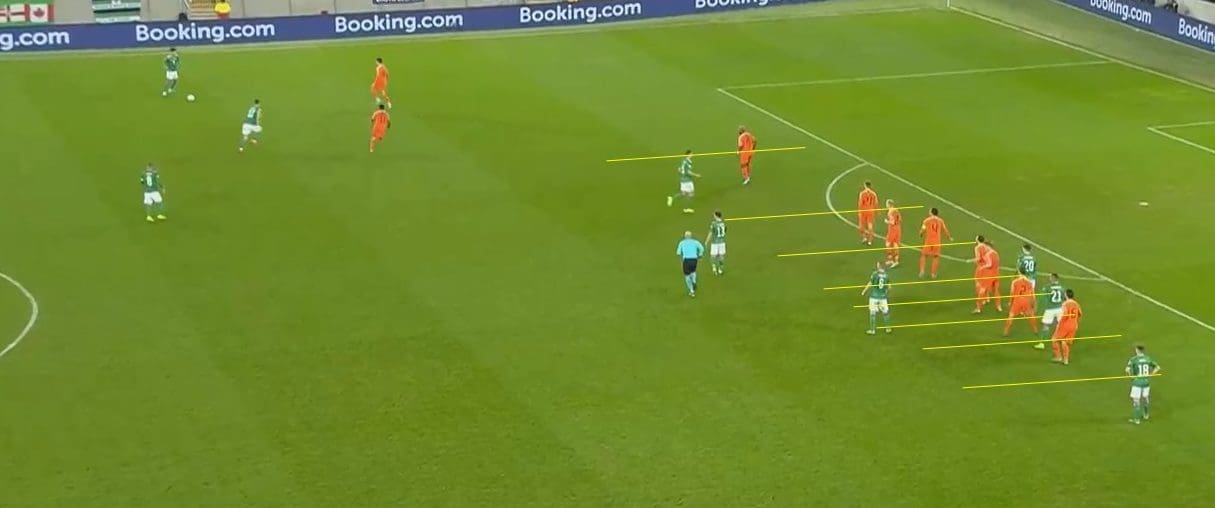
Here, Koeman’s side’s longitudinal zonal marking can be seen later in the game, after the home side had been awarded and missed a penalty. Notice, that instead of a larger section, the Netherlands players now have a one-to-two-yard wide section of the pitch to cover, as opposed to a wider section in the earlier annotation. The totaalvoetbal masters are much more bunched together and compact to avoid the gaps between the players being exposed, as Northern Ireland had previously used to their advantage.
Northern Ireland’s crosses from deep
To expose the zonal nature of the Netherlands’ defence, O’Neill pinpointed the vulnerability in that if his side could play crosses from deep, into the areas between defenders, they would be presented with goalscoring opportunities. As such, where possible, Northern Ireland’s wide players – Gavin Whyte and Saville – whipped crosses from deeper than usual into the areas in between Koeman’s defenders.
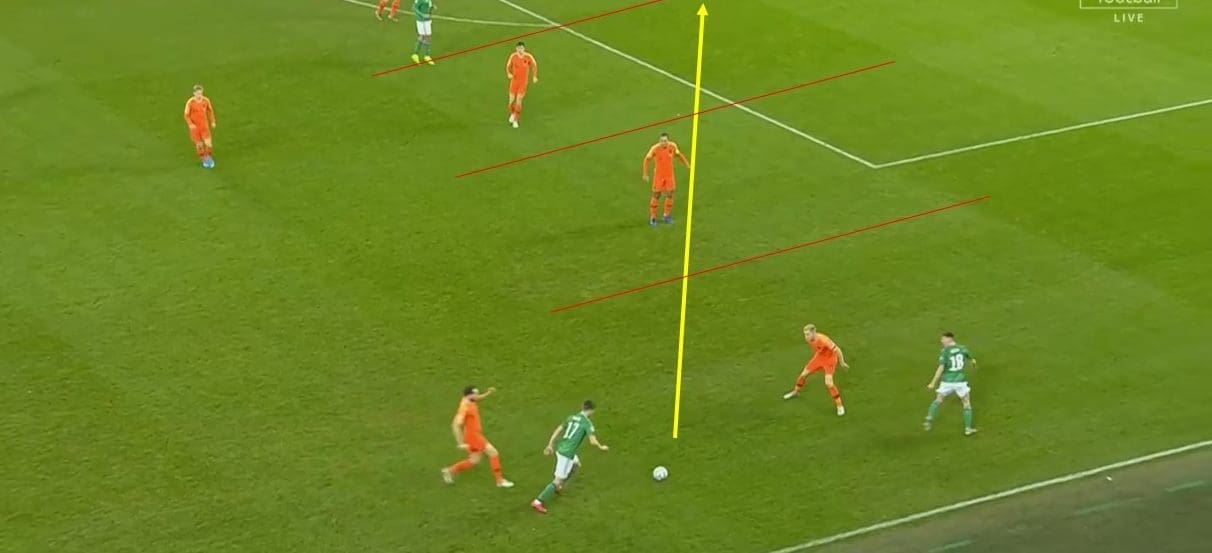
Here, within the first five minutes of the game, Paddy McNair has moved out wide for Northern Ireland and offers the first example of this crossing tactic. The yellow arrow marks the trajectory of the ball, as it is floated towards the red line, having been played in between the longitudinal zones of two of the Oranje’s defensive players. In this instance, Magennis’ header goes just wide of Cillessen’s goal.
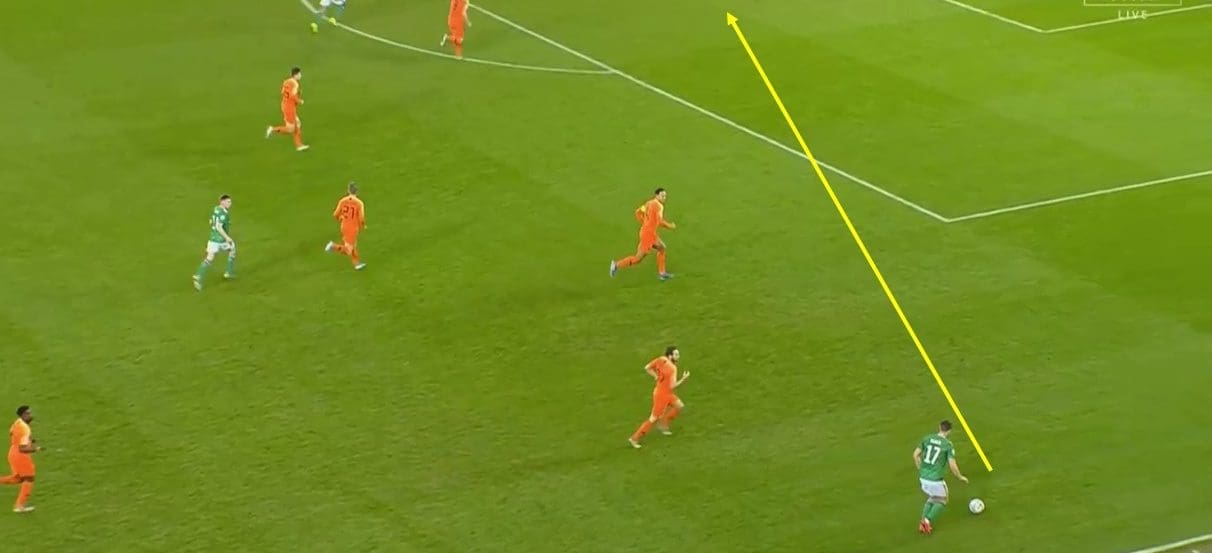
The above annotation is taken from the build-up to Northern Ireland winning their first-half penalty – which Steven Davies went on to miss. Although slightly more advanced, McNair again crosses the ball from deep into a similar area as the previous annotation. The intent of this was to cause Koeman’s backline issues, which it did. With de Roon blindsided by the run of Saville, due to where the cross was delivered, his recovery run leads him to end up blocking the shot with his hand, resulting in the penalty.
Conclusion
While the Netherlands entered the tie as favourites and, therefore, will perhaps be disappointed not to have come away with a victory, qualification will have been all that was on Ronald Koeman’s mind. The Oranje are back and, to them, that is all that will matter.
Michael O’Neill will also be disappointed that his side was not able to jump over their opponents by claiming victory, especially with the missed penalty. However, Northern Ireland has had an impressive qualifying campaign and will be tough opponents for whoever they face in the play-offs.
This tactical analysis has highlighted areas of the two sides’ tactics that were influential in the outcome of the match and used analysis to further explain them.

If you love tactical analysis, then you’ll love the digital magazines from totalfootballanalysis.com – a guaranteed 100+ pages of pure tactical analysis covering topics from the Premier League, Serie A, La Liga, Bundesliga and many, many more. Buy your copy of the November issue for just ₤4.99 here





Comments